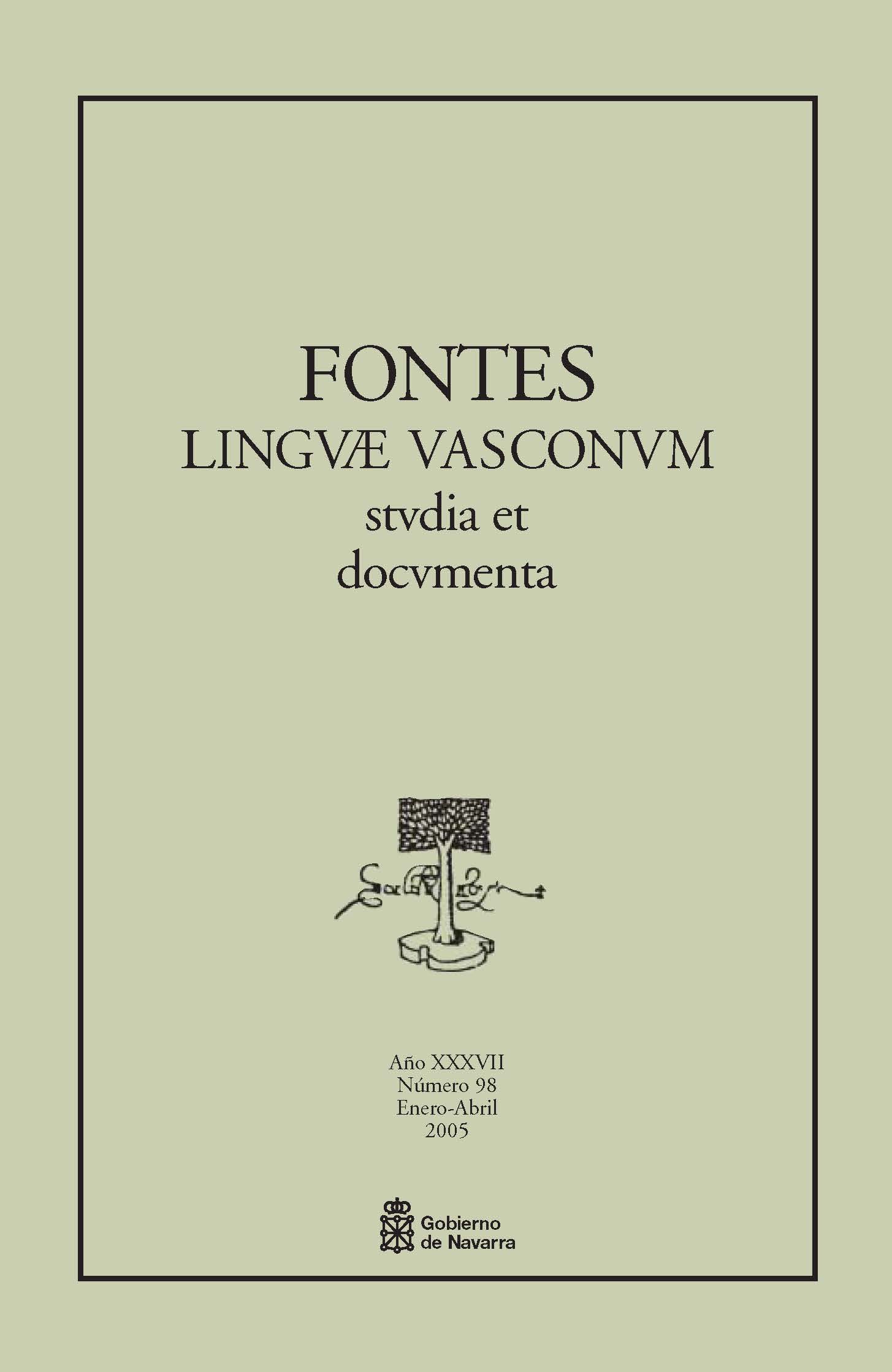Zaraitzuera aztertzeko ekarpen berriak (8 - Espartza: taulak/esaldiak)
Resumen
Con éste son cinco los pueblos del valle de Salazar cuyo euskara, de algún modo, hemos tratado de examinar. Esta entrega tendrá en todo caso continuidad en la subtitulada ‘(9 - Espartza: ahozko testuak)’, donde, tal como hicimos con datos recogidos en Ochagavía, presentaremos diversos relatos de interés, pudiendo entre ellos, por ejemplo, imaginar la construcción y bajada de almadías a través del río Salazar y la trashumancia de ganado lanar a través de la llamada Cañada de los salacencos. Al ser estos materiales bastante abundantes, los textos elegidos también se prolongarán algo más que los publicados anteriormente, aunque no todos los informantes, cosa sencilla de comprender, hayan mostrado el mismo nivel de conocimiento en el empleo del idioma hablado. El euskara de Salazar, tal como venimos diciendo en estos resúmenes de fin de entrega, fue incluido por el vascófilo príncipe LuisLoucien Bonaparte, en su meritísimo mapa, dentro del dialecto bajo-navarro oriental, siendo, al parecer, una de las razones de mayor peso para tal inclusión el empleo en dicho euskara de la alocución respetuosa, común a los dialectos orientales.
Estadísticas
Referencias
ARANA, A., Zaraitzuko Hiztegia, Nafarroako Gobernua eta Hiria Liburuak, 2001.
ARANZADI ZIENTZI ELKARTEA - ETNOLOGIA MINTEGIA, Euskalerriko Atlas Etnolinguistikoa (EAEL), I eta II, Donostia, 1983 eta 1990, hurrenez hurren.
ARTOLA, K., "Erronkariko uskararen azken hatsak… eiro're!!", FLV, 25, 1977.
ARTOLA, K., "Fidela Bernat anderea, euskal hiztun erronkariarra (I)", FLV, 58, 1991.
ARTOLA, K., "Zaraitzuera aztertzeko ekarpen berriak" (1, 2, 3, 4, 5, 6 eta 7), FLV, 91, 92, 93, 94, 95, 96 eta 97, 2002-2004.
AZKUE, R. M. de, "Particularidades del dialecto roncalés", Euskera, II-III-IV, Euskaltzaindia, 1931.
AZKUE, R. M. de, Diccionario vasco-español-francés (repr. facsímil), Edit. La Gran Enciclopedia Vasca, Bilbao, 1969.
BELOKI, J. J.; ELOSEGI, J.; SANSINENEA, P. eta MITXELENA, K., "Contribución al conocimiento del dialecto roncalés", BRSVAP, IX-4º, Donostia, 1953.
ECHAIDE ITARTE, A. M., El euskera en Navarra: Encuestas lingüísticas (1965-1967), Eusko Ikaskuntza, Donostia, 1989.
EUSKALERRIKO IRRATIA, Nafarroako euskaldunen mintzoak (II), Nafarroako Gobernua, 1993.
IRIBARREN, J. M., Vocabulario navarro (nueva edición preparada y ampliada por Ricardo Ollaquindia), Institución Príncipe de Viana, Iruñea, 1984.
IZAGIRRE, K., "Erronkariko euskal-ondakin batzuk", BRSVAP, XV-3º, Donostia, 1959.
MITXELENA, K., "Un catecismo salacenco", FLV, 39, 1982.
SANZ ZABALZA, F., Maderistas y almadieros del Roncal, 1945-1955, Copia, Iruñea, 1993.
SATRUSTEGI, J. M., Euskal testu zaharrak - Zaraitzu (1780), Nafarroako Gobernua eta Euskaltzaindia, 1987.
SATRUSTEGI, J. M., "Zaraitzuko euskararen lekukoak", Luis Villasanteri Omenaldia, Iker, 6, Euskaltzaindia, 1992.
YRIZAR, P. de, Contribución a la dialectología de la lengua vasca (I), Gipuzkoako Aurrezki Kutxa Probintziala, Donostia, 1981.
YRIZAR, P. de, Morfología del verbo auxiliar roncalés, Euskaltzaindia, 1992.
YRIZAR, P. de, Morfología del verbo auxiliar bajo navarro oriental (I, II eta III), Euskaltzaindia, 1999-2002.
Derechos de autor 2005 Koldo Artola

Esta obra está bajo licencia internacional Creative Commons Reconocimiento-NoComercial 4.0.







